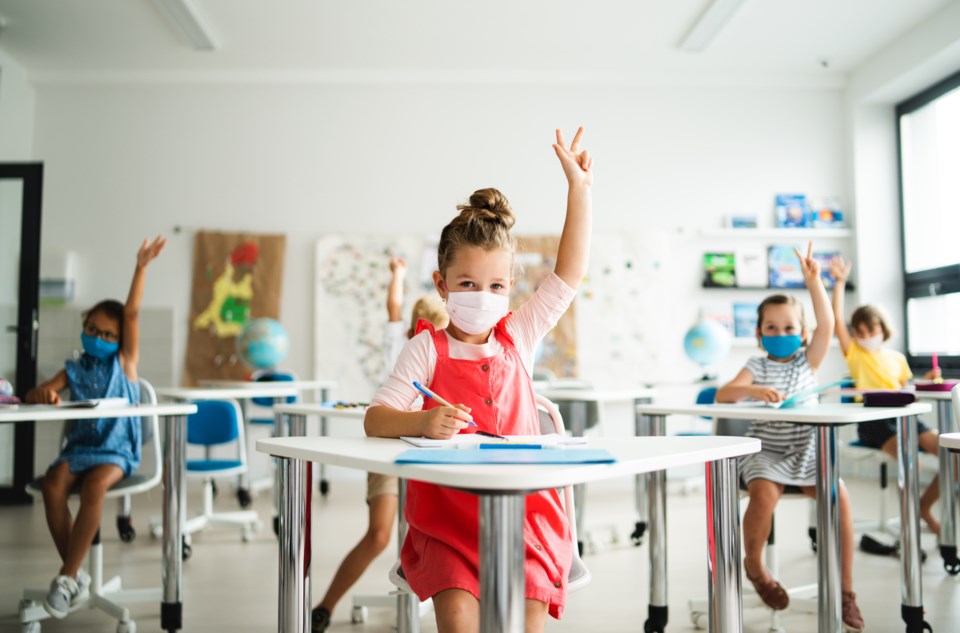Spring break is over and so is the mask mandate in British Columbia, and as kids returned to schools the hashtag #CovidIsntOver was trending on Twitter.
Many have been vocal under the hashtag, parents and teachers included, with many stories and concerns over kids catching the virus and bringing it home.
Kyenta Martins sends her grade five and grade seven children, both vaccinated, to school in East Vancouver with KN95 masks that stay on the entire day.
Though she’s not comfortable with sending her kids to school, after considering the mental health impacts of keeping her kids home, she says she feels like she doesn’t really have a choice.
“They were still connected to their school community, and at that time that was the best choice. But for this year, they really need the social interaction,” she tells Vancouver Is Awesome over the phone.
Both kids wear KN95 masks and don’t take them off inside the classroom, even to eat. Martins comes by regularly to take her kids outside for lunch.
Burnaby elementary school teacher Jennifer Heighton is just as concerned for the kids as she is for staff safety. She says that mask ratios vary between schools, and although the school she teaches at is “pretty good” with wearing masks, she’s heard of other schools with up to 80% unmasked while others report 50% unmasked.
Preschool-aged kids
Children in British Columbia are eligible to get vaccinated for COVID-19 starting at the age of five, but those who are younger don’t have a vaccine option available. Both parents and teachers, like Martins and Heighton, are concerned for the risks posed to preschool-aged kids attending school and younger children who are indirectly exposed like toddlers and babies.
“There are people who have chosen not to get vaccinated, but there are people like preschoolers and others who can not get vaccinated. And so what are we doing to protect them? I mean, almost nothing,” says Martins. “It's a vascular disease, so it can cause heart attacks and type two diabetes and a whole host of other side effects or problems within our bodies.”
“It's really important that we protect that youngest age group, especially with the Omicron variant– it's affecting younger children more seriously than previous variants did,” says Heighton, citing a CDC study which showed that the Omicron variant sent five times more children under the age of five to the hospital than previous variants.
“There's no vaccine approved for them,” Heighton continues. “And parents of young children like toddlers are in this very difficult position, especially if they have siblings that go to school [like] a brother or sister that's in grade one, for example. It's a concern because if you don't have schools as safe as possible, then there's a chance that you're putting your family at risk.”
Ventilation
Both Martins and Heighton strongly emphasize fresh air and ventilation in B.C. schools, adding that it isn’t discussed enough.
“When you talk to people about ventilation filtration, that information on how that can protect people on improving indoor air has not been clearly communicated by our government. And so it's not used,” says Martins.
“There needs to be maximum fresh air to dilute any potential viral particles, and that hasn't been dealt with at all. So [health officials] removed the mask mandate but did not emphasize that windows need to be open, carbon dioxide monitors should be in classrooms to establish that you're getting enough fresh air, and there should be HEPA filtration units in every classroom because the kids can't [distance themselves],” explains Heighton.
“It's a highly occupied space. So there's way more kids in a classroom than would be in an equivalent sized clothing store, for example,” Heighton adds. “If you visited a clothing store, you might only spend a short time [in there] and you're not breathing the same air for a [long time].”
According to Heighton, considering the inability to properly ventilate, socially distance and the low vaccination rate, schools should have been an exception.
Not far off
With an eye on the ongoing COVID-19 surge in the U.K., Heighton claims B.C. is not far behind. “The U.K. is about a month ahead of us. They removed their mask mandate on February 22." B.C.'s mask mandate for the general population was lifted March 11; B.C. school kids returned March 28 following spring break to no mask mandate.
“[The virus] mutated to the point where previous infections don't save you. That's why the U.K. is struggling. So that's going to happen here, unfortunately, unless we get this mask mandate back and unless we get the other protections put back into place,” Heighton adds.
Both Martins and Heighton are members of Safe Schools Coalition B.C., an group of “parents, educators, and concerned citizens advocating for evidence-based COVID-19 safety measures in British Columbia schools,” as reads the group’s Twitter bio.
The group wrote a public letter to BC Education stakeholders as a call to action, addressing concerns over vaccination rates, “Long-COVID” in children, the BA.2 variant, adequate ventilation and the urgency in returning the mask mandate.


